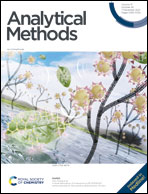Magnetic field induced high-density SERS active assembly of Fe3O4@Au nanostars in a glass capillary for food colorant detection†
Abstract
The Fe3O4@Au nanostars, whose anisotropic shape couples the plasmons focused on the magnetic core with the branches of the gold shell, hold promise for surface enhanced Raman spectroscopy (SERS) applications. Assembly of monodisperse Fe3O4@Au nanostars induced by a magnetic field could lead to highly ordered superstructures, providing distinctive SERS activity. In this study, a simplified fabrication technique was developed to assemble Fe3O4@Au nanostars on the inner walls of a glass capillary into a highly sensitive, reproducible and recyclable SERS active glass capillary under controlled magnetic alignment. The strong dipole–dipole interactions between the neighboring nanoparticles lead to a close-packed pattern as an energetically favorable configuration. The magnetic dipolar interaction between the particles can be further tuned by the controlled anisotropic shape of the gold shell. The interparticle plasmon couplings and lightning rod effects of the Fe3O4@Au nanostars contributed to Raman enhancement. Based on the capillary action, capillaries can act as a microreactor for the sampling tools. We further demonstrate SERS-based colorant detection in the capillary which the target molecule can easily detect by simple adsorption of the colorants by capillary action. The Fe3O4@Au nanostars in the capillary with a long shelf life, high sensitivity and low cost promote the application of SERS technology in widespread fields.



 Please wait while we load your content...
Please wait while we load your content...